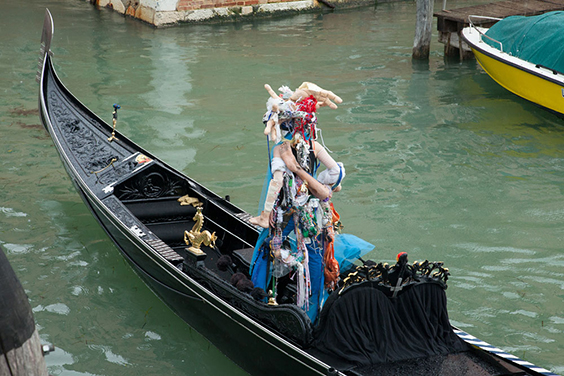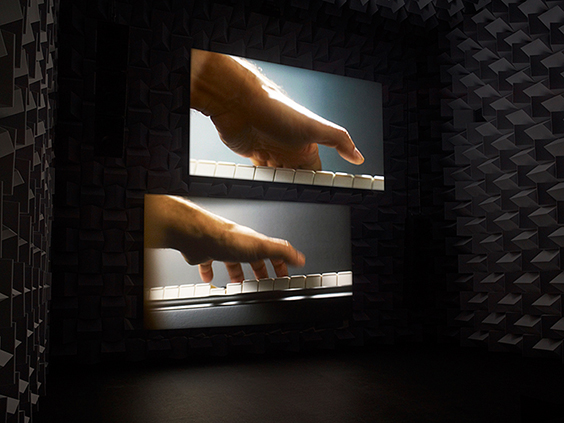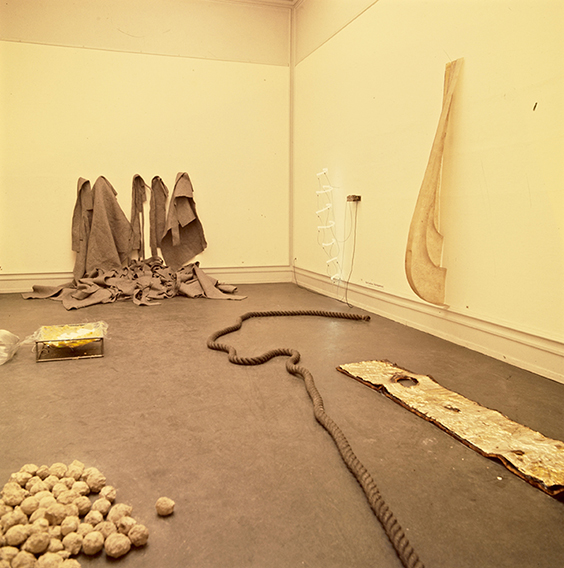
Raphaëlle de Groot’s performance during the preview week for the Venice Biennale. Courtesy Galerie de l’UQAM. Photo: Gwenaël Bélanger
Venice Digest
■Tino Sehgal won the Golden Lion prize for best artist, in Massimiliano Gioni’s “The Encyclopaedic Palace†exhibition at the 55th Venice Biennale. Seghal’s acceptance speech at the ceremony can be heard here. [BiennaleChannel]
â– The Golden Lion for best National pavilion was awarded to Angola, who presented in Venice for the first time with a commission by two architects (Paula Nascimento and Stefano Rabolli Panserato) to curate “Beyond Entropyâ€. The concept of the exhibition started off with the paradoxical nature of the Biennale’s theme, The Encyclopaedic Palace, claiming that: “No building could ever contain all the knowledge of the worldâ€. Nascimento and Panserato’s interview can be seen here. [BiennaleChannel]
■Hayward Gallery director Ralph Rugoff talks to Jeremy Deller on “English Magic†at the British Pavilion. [ArtFund UK]
â– Anri Sara’s “Ravel Ravel Unravel†created subtle yet thought provoking meditations on the future of Europe at the French national pavilion (which was exchanged with Germany’s this year) [Phaidon] Read Anri Sala’s interview with Paris based writer and musician Robert Barry on [Frieze blog]
■Meanwhile, Susanne Gaesheimer, curator for the German building is providing a critical examination of what “national representation†entails in different countries, by featuring four international artists: Ai Weiwei, Romuald Karmakar, Santu Mofokeng and Dayanita Singh. [domus]
■Alfredo Jaar taunts the interminable controversies surrounding national pavilions with his work: “Drowning the Giardini†[The Art Newspaper]

View of Anri Sala, Ravel Ravel Unravel, 2013. French Pavilion, 55th Venice Biennale. Photo by Marc Domage.
â– Beyond the German pavilion, Ai Weiwei shows two other large-scale works at the Biennale, including “SACREDâ€, a disturbing re-enactment video of his 2011 detention, displayed in the church of Saint-Antonin. [The Guardian]
â– Belinda de Bruyckere invites Nobel laureate J. M. Coetzee to curate the Belgian Pavilion. [GalleristNY]
â– Boznia and Herzegovina return to Venice after 10 years of absence [The Art Newspaper]
â– Bil Culbert, the 78 year-old artist representing New Zealand is introducing “an energy and simplicity†with his installation “Front Door Out Backâ€, preferring this to bold statements and clunks of theory. [Phaidon]
â– Rirkrit Tiravanija talks with Sarah Sze about “Tripe Pointâ€, her large scale installations at the US Pavilion [Artforum]
â– Shary Boyle’s “Music of Silence†proposed at the Canadian Pavilion received mixed review by Art F City’s Paddy Johnson, who first thought that the work was terrible, then “Actually, not too badâ€. [Art F City] Boyle described her contribution as “weirdly Pinocchio, shamanistic, Doctor Frankenstein …â€, more reviews of Boyle’s work in Venice are accessible on [Canadian Art], [National Post], [The Wall Street Journal] as well as an interview: [Globe and Mail]
■Montreal’s Galerie de l’UQAM (@GaleriedelUQAM) and Canadian Art (@canartca) were posting minute-by-minute tweets for Raphaëlle de Groot’s unofficial presentation at the “improvising pavilion†in Venice. A more complete report of de Groot’s performance is available on [Canadian Art] mag.

Inside the Iraq pavilion, the art collective Wami (comprising Yaseen Wami and Hashim Taeeh) present their cardboard landscape Welcome to Iraq. Photo: David Levene for the Guardian
■The Biennale’s Iraqi pavilion was curated by Birmingham’s Ikon Gallery director Jonathan Watkins and commissioned by the Ruya Foundation for Contemporary Culture in Iraq. [Ibraaz] offers an online interview with Ruya founding members Tamara Chalabi and Reem Shather-Kubba.
■From Japan’s video installation of post-quake memory to Turkey’s robots and tattoos – five pavilions that reveal Asia’s diversity. [Art Rader Asia]
â– Working in collaboration with artist Thomas Demand and architects Rem Koolhaas and Germano Celant, the curator of the Fandazione Prada at the Ca’ Corner della Regina palace revisits Harold Szeemann’s 1969 groundbreaking exhibition “Live in Your Head: When Attitudes Become Formâ€, held on the Grand Canal. The much-discussed recreated show has captured the heart of Guardian critic Adrean Seale, as read in [The Guardian] and also by [Frieze blog] and [GalleristNY]
■ArtSpace posted a manual for correctly pronouncing eccentric artists’ names, without embarrassing anyone among highbrow art gatherings like the Venice Biennale. [ArtSpace Volume 1 & 2]
■Selected slide shows: [The Guardian], [ArtInfo], [The Wall Street Journal], [ARTiT: part 1, 2, 3, 4], For Maldives and Tuvalu’s pavilion [ArtInfo]
Other Links
■The beautiful writing of Roberta Smith on Donald Judd’s home/museum on 101 Spring Street, including her own personal memoirs of Judd in his living/working space. [The New York Times]
â– The Vatican has revealed that it is going to spend millions of Euros to build new churches, and in the process will commission some of the world’s greatest contemporary artists to furnish the holy structures. [The Independent]
â– Amazon is planning a new venture called “Amazon Fine Art Galleryâ€, scheduled to launch this summer. [Phaidon]

Installation view of When Attitudes Become Form: Bern 1969/Venice 2013. Courtesy Fandazione Prada. Photograph: Balthasar Burkhard/J Paul Getty Trust
